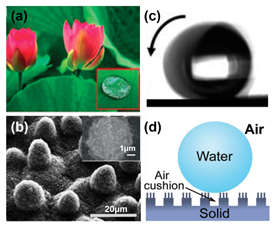In 1997, Wilhelm Barthlott (University of Bonn, Germany) discovered that, the water droplets turned into rolling state while dropping on the lotus surface, taking away the contaminated medium such as dust, so as to maintain a state of spotlessness. It is called "Lotus Effect." Researchers observed that, there are large plenty of micron-sized mastoid structures and nano-scale waxy with low surface energy crystals on the lotus surface, constituting a micro-nano hierarchical structure. The synergistic effect of sufficient roughness and low surface energy chemistry makes the lotus leaf have a high contact angle and a low rolling angle, exhibiting a super-hydrophobic self-cleaning state. At present, it has been applied in the fields of construction, textile, aviation, communication and so on.
Lotus is out of the mud and not dyed. The lotus leaf is a perennial aquatic plant with a rhizome of the Nymphaeaceae, pleasing to warm and water. After the leaves are round-shaped, full or slightly undulating, floating above the water surface, which is not susceptible to residual contaminants. Based on the SEM images, Lotus surface is covered with many randomly distributed papillae with diameters ranging from 5 to 9μm [1]. Moreover, there are also many nano-scale branch-like structures of epicuticular waxes with average diameters of 124.3 ± 3.2 nm on each papilla, constituting a micro-nano hierarchical structure. The "Lotus Effect" provides an excellent reference for biomimetic wettability surfaces and structural design.
The micro-scale papillae and nano-scale wax crystal structure on the lotus surface capture air at the groove to form an "air cushion", which generates a negative pressure. Thus, the water droplet is not completely immersed in the surface rough structures during contact with the surface, possessing a high water contact angle and an extremely small rolling angle, preventing the lotus leaf from being wetted by water effectively, thus exhibiting excellent super-hydrophobic self-cleaning phenomenon.

Figure 1 (a) Optical image of Lotus leaf. (b) SEM image [1]. (c) The superhydrophobic rolling state of water droplet.
(d) Wettability mechanism (Cassie model)
By mimicking the lotus effect, the biomimetic superhydrophobic surfaces have the characteristics of self-cleaning, anti-fouling, anti-icing, drag reduction and anti-corrosion etc. Nowadays, it is very widespread applied in the fields of architecture, textile, aviation and communication etc.
[1] Barthlott W, Neinhuis C. Purity of the sacred lotus, or escape from contamination in biological surfaces. Planta, 1997, 202(1): 1-8.
[2] Feng L, Li S H, Li Y S, et al. Super-Hydrophobic Surfaces: From Natural to Artificial. Advanced Materials, 2002, 14: 1857-1860.
[3] Zhang J H, Wang J M, Zhao Y, et al. How does the leaf margin make the lotus surface dry as the lotus leaf floats on water? Soft Matter, 2008, 4, 2232-2237.
[4] Roach P, Shirtcliffe N J, Newton M I. Progress in superhydrophobic surface development. Soft Matter, 2008, 4(2): 224.
[5] Jiang L, Zhao Y, Zhai J. A Lotus-leaf-like superhydrophobic surface: a porous microsphere/nanofiber composite film prepared by electrohydrodynamics. Angewandte Chemie-Interational Edition, 2004, 43(33): 4338-4341.
[6] Liu K S, Yao X, Jiang L. Recent developments in bio-inspired special wettability. Chemical Society Reviews, 2010, 39(8): 3240.
[7] Fürstner R, Barthlott W, Neinhuis C, Walzel P. Wetting and self-cleaning properties of artificial superhydrophobic surfaces. Langmuir, 2005, 21(3): 956-961.
[8] Bharat B, Jung Y C. Natural and biomimetic artificial surfaces for superhydrophobicity, self-cleaning, low adhesion, and drag reduction. Progress in materials science, 2011, 56(1): 1-108.
[9] Patankar N A. Mimicking the Lotus Effect: Influence of Double Roughness Structures and Slender Pillars. Langmuir, 2004, 20(19): 8209.
[10] Latthe S S, Terashima C, Nakata K, Fujishima A. Superhydrophobic Surfaces Developed by Mimicking Hierarchical Surface Morphology of Lotus Leaf. Molecules, 2014, 19(4): 4256-4283.
[11] Koch K, Bhushan B, Jung Y C, Barthlott W. Fabrication of artificial Lotus leaves and significance of hierarchical structure for superhydrophobicity and low adhesion. Soft Matter, 2009, 5(7): 1386.
[12] Wang S T, Liu K S, Yao X, Jiang L. Bioinspired surfaces with superwettability: new insight on theory, design, and applications. Chemical Reviews, 2015, 115 (16): 8230-8293.
[13] https://baike.sogou.com/v628402.htm
Wilhelm Barthlott
Lei Jiang
